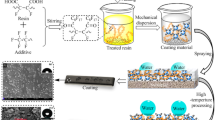Abstract
In this study, 1-wt% fluorinated couple agents were firstly used to modify the surface of high barrier graphene platelets (HBG). Then the modified HBG were incorporated into ethylene propylene diene monomer (EPDM). Due to high lamellar size/thickness ratio (about 3300), untreated HBG (HBG-un) increase the complex viscosity of EPDM composites. The surface modification of HBG by heptadecafluoro-decyl-triethoxy silane (17F) can reduce the surface energy of HBG and then decrease the complex viscosity of EPDM/HBG-un from 21,000 to 13,000 Pa s (about 40% decrease) at 1.7 Hz. Due to the increased physical entanglement and C=C bonds, HBG-un can increase the tensile and tear strength of EPDM control by about 3 and 2 times, respectively. The surface modification of 17F can slightly reduce the tensile and tear strength of EPDM/HBG-un by 9% and 8%, respectively. HBG-un can increase the thermal conductivity and dielectric constant of EPDM control by 17% and 2.8 times increase, respectively. Surface modification of 1-wt% 17F can remarkably reduce the dielectric loss of EPDM/HBG-un by 50% at 20 MHz, slightly affecting the dielectric constant and thermal conductivity. In addition, HBG-un can decrease the volume and surface resistivity of EPDM control by 2 and 1 order of magnitude, respectively, while 1-wt% 17F can both increase the surface and volume resistivity of EPDM by one order of magnitude.








Similar content being viewed by others
Data availability
The datasets generated during and/or analyzed during the current study are available from the corresponding author on reasonable request.
References
J. Wang, W. Zhang, Q. Yin, J. Mater. Sci. 31, 125 (2020)
A.R. Marlinda, N.H. Kamaruddin, A.W. Fadilah, Polym. Eng. Sci. 61, 1476 (2021)
J. Su, J. Zhang, RSC Adv. 96, 78448 (2015)
W. Dong, L. He, C. Chen, J. Mater. Sci. 33, 1817 (2022)
J. Su, J. Zhang, Plast. Rubber Compos. 45, 127 (2016)
J. Su, J. Zhang, J. Mater. Sci. 28, 5250 (2017)
J. Su, J. Zhang, Composites B 112, 148 (2017)
J. Su, C. Li, J. Mater. Sci. 32, 9065 (2021)
Y. Zhu, S. Murali, W. Cai, Adv. Mater. 22, 3906 (2010)
Ö.B. Mergen, J. Compos. Mater. 55, 4347 (2022)
M. Rahman, G. Tong, N. Kamaruddin, J. Mater. Sci. 30, 12888 (2019)
S. Wu, J. Wang, J. Shao, ACS Appl. Mater. Interface 9, 28887 (2017)
G. Yin, Y. Yang, F. Song, ACS Appl. Mater. Interface 9, 5237 (2017)
S. Wageh, A. Ghamdi, A. Numan, J. Iqbal, J. Mater. Sci. 31, 8127 (2020)
H. Salavagione, G. Martínez, G. Ellis, Macromol. Rapid. Commun. 32, 1771 (2011)
M. Itkis, P. Ramesh, C. Berger, J. Am. Chem. Soc. 131, 1336 (2009)
A. Krainoi, C. Kummerlöwe, Y. Nakaramontri, Polym. Test. 66, 122 (2018)
A. Shakun, M. Poikelispää, A. Das, Polym. Eng. Sci. 58, 395 (2018)
H.A. Qasem, M.R. Aouad, H.A. Al-Abdulkarim, J. Mol. Struct. 1264, 133263 (2022)
A.M. Abu-Dief, R.M. El-khatib, F.S. Aljohani, J. Mol. Struct. 1242, 130693 (2021)
J. Su, S. Chen, J. Zhang, J. Appl. Polym. Sci. 122, 3277 (2011)
J. Su, S. Chen, J. Zhang, J. Compos. Mater. 46, 589 (2012)
M. Ishiharaa, A. Koshiob, A. Nakayama, Mater. Lett. 61, 1068 (2007)
T. Chowdhury, R. Hidayat, H. Kim, Appl. Surf. Sci. 554, 149481 (2007)
J. Trinidad, B. Amoli, W. Zhang, J. Mater. Sci. 27, 12955 (2019)
K.H. Rahiman, G. Unnikrishnan, A. Sujith, Mater. Lett. 59, 633 (2005)
A. Singh, B. Panda, S. Mohanty, Polym. Adv. Technol. 28, 1851 (2017)
H. Wu, W. Zhou, Q. Liu, J. Appl. Polym. Sci. 139, 51838 (2022)
Z. Bo, W. Zhu, W. Ma, Adv. Mater. 25, 5799 (2013)
C. Teng, C. Ma, C. Lu, Carbon 49, 5107 (2011)
Y. Zhao, X.D. Jia, L. Li, Polym. Sci. Ser. B 64, 229 (2022)
S. Pongdhorn, S. Chakrit, T. Uthai, Polym. Test. 23, 871 (2004)
C. Nakason, P. Wannavilai, A. Kaesaman, Polym. Test. 25, 34 (2006)
X. Liu, X. Hong, B. Liang, J. Polym. Res. 29, 146 (2022)
X. Xiang, Y. Zhu, M. Yin, J. Mater. Sci. 57, 3280 (2022)
N. Dishovsky, F. Tantawy, R. Dimitrov, Polym. Test. 23, 69 (2004)
R. Salunkhe, Y. Lee, K. Chang, Chem. Eur. J. 20, 13838 (2014)
Funding
The work was supported by the Nanjing Vocational University of Industry Technology Scientific Research Foundation for the introduction of talent (YK19-01-02).
Author information
Authors and Affiliations
Contributions
JS contributed to the study conception, design, material preparation, data collection, and analysis. JS wrote the first draft of the manuscript, read and approved the final manuscript.
Corresponding author
Ethics declarations
Conflict of interest
The authors have no relevant financial or non-financial interests to disclose.
Ethical approval
This study has no disclosure of potential conflicts of interest. The research involving no Human Participants and/or Animals.
Additional information
Publisher's Note
Springer Nature remains neutral with regard to jurisdictional claims in published maps and institutional affiliations.
Rights and permissions
Springer Nature or its licensor holds exclusive rights to this article under a publishing agreement with the author(s) or other rightsholder(s); author self-archiving of the accepted manuscript version of this article is solely governed by the terms of such publishing agreement and applicable law.
About this article
Cite this article
Su, J. Reduction of dielectric loss of ethylene propylene diene monomer (EPDM) with high barrier graphene (HBG) modified by heptadecafluoro-decyl-triethoxy silane. J Mater Sci: Mater Electron 33, 24519–24527 (2022). https://doi.org/10.1007/s10854-022-09163-z
Received:
Accepted:
Published:
Issue Date:
DOI: https://doi.org/10.1007/s10854-022-09163-z




